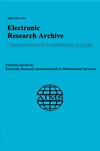EECHS-ARO: Energy-efficient cluster head selection mechanism for livestock industry using artificial rabbits optimization and wireless sensor networks
IF 1
4区 数学
Q1 MATHEMATICS
引用次数: 4
Abstract
In the livestock industry, wireless sensor networks (WSNs) play a significant role in monitoring many fauna health statuses and behaviors. Energy preservation in WSNs is considered one of the critical, complicated tasks since the sensors are coupled to constrained resources. Therefore, the clustering approach has proved its efficacy in preserving energy in WSNs. In recent studies, various clustering approaches have been introduced that use optimization techniques to improve the network lifespan by decreasing energy depletion. Yet, they take longer to converge and choose the optimal cluster heads in the network. In addition, the energy is exhausted quickly in the network. This paper introduces a novel optimization technique, i.e., an artificial rabbits optimization algorithm-based energy efficient cluster formation (EECHS-ARO) approach in a WSN, to extend the network lifetime by minimizing the energy consumption rate. The EECHS-ARO technique balances the search process in terms of enriched exploration and exploitation while selecting the optimal cluster heads. The experimentation was carried out on a MATLAB 2021a platform with varying sensor nodes. The obtained results of EECHS-ARO are contrasted with other existing approaches via teaching–learning based optimization algorithm (TLBO), ant lion optimizer (ALO) and quasi oppositional butterfly optimization algorithm (QOBOA). The proposed EECHS-ARO enriches the network lifespan by ~15% and improves the packet delivery ratio by ~5%.基于人工兔子优化和无线传感器网络的畜牧业节能簇头选择机制
在畜牧业中,无线传感器网络(WSNs)在监测许多动物的健康状况和行为方面发挥着重要作用。由于传感器与有限的资源相耦合,因此在无线传感器网络中节能被认为是一项关键而复杂的任务。因此,聚类方法在wsn中具有有效的能量保存功能。在最近的研究中,引入了各种聚类方法,这些方法使用优化技术通过减少能量消耗来提高网络寿命。然而,它们需要更长的时间来收敛并在网络中选择最佳簇头。此外,网络中的能量消耗很快。本文介绍了一种新的优化技术,即基于人工兔子优化算法的能量高效簇形成(EECHS-ARO)方法,通过最小化能量消耗率来延长网络寿命。EECHS-ARO技术在选择最佳簇头的同时,在丰富的探索和开发方面平衡了搜索过程。实验在具有不同传感器节点的MATLAB 2021a平台上进行。通过基于教与学的优化算法(TLBO)、蚁狮优化算法(ALO)和拟对偶蝴蝶优化算法(QOBOA),将EECHS-ARO算法的结果与现有方法进行对比。提出的EECHS-ARO使网络寿命延长了约15%,数据包传输率提高了约5%。
本文章由计算机程序翻译,如有差异,请以英文原文为准。
求助全文
约1分钟内获得全文
求助全文

 求助内容:
求助内容: 应助结果提醒方式:
应助结果提醒方式:


